E.Pound翻译家 庞德及 翻译理论 简介
- 格式:ppt
- 大小:1.88 MB
- 文档页数:4
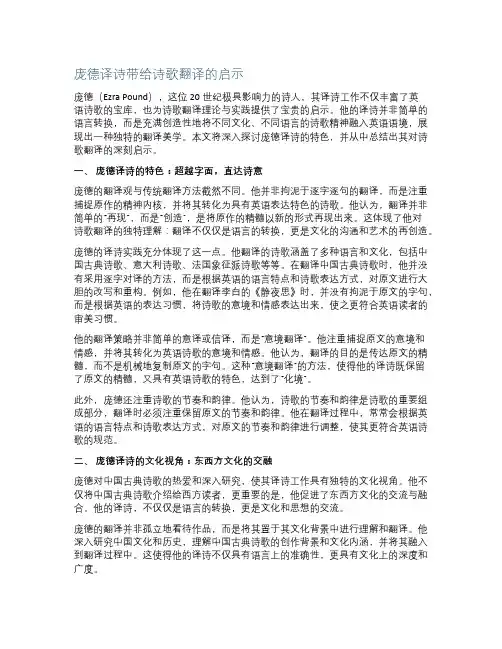
庞德译诗带给诗歌翻译的启示庞德(Ezra Pound),这位20世纪极具影响力的诗人,其译诗工作不仅丰富了英语诗歌的宝库,也为诗歌翻译理论与实践提供了宝贵的启示。
他的译诗并非简单的语言转换,而是充满创造性地将不同文化、不同语言的诗歌精神融入英语语境,展现出一种独特的翻译美学。
本文将深入探讨庞德译诗的特色,并从中总结出其对诗歌翻译的深刻启示。
一、庞德译诗的特色:超越字面,直达诗意庞德的翻译观与传统翻译方法截然不同。
他并非拘泥于逐字逐句的翻译,而是注重捕捉原作的精神内核,并将其转化为具有英语表达特色的诗歌。
他认为,翻译并非简单的“再现”,而是“创造”,是将原作的精髓以新的形式再现出来。
这体现了他对诗歌翻译的独特理解:翻译不仅仅是语言的转换,更是文化的沟通和艺术的再创造。
庞德的译诗实践充分体现了这一点。
他翻译的诗歌涵盖了多种语言和文化,包括中国古典诗歌、意大利诗歌、法国象征派诗歌等等。
在翻译中国古典诗歌时,他并没有采用逐字对译的方法,而是根据英语的语言特点和诗歌表达方式,对原文进行大胆的改写和重构。
例如,他在翻译李白的《静夜思》时,并没有拘泥于原文的字句,而是根据英语的表达习惯,将诗歌的意境和情感表达出来,使之更符合英语读者的审美习惯。
他的翻译策略并非简单的意译或信译,而是“意境翻译”。
他注重捕捉原文的意境和情感,并将其转化为英语诗歌的意境和情感。
他认为,翻译的目的是传达原文的精髓,而不是机械地复制原文的字句。
这种“意境翻译”的方法,使得他的译诗既保留了原文的精髓,又具有英语诗歌的特色,达到了“化境”。
此外,庞德还注重诗歌的节奏和韵律。
他认为,诗歌的节奏和韵律是诗歌的重要组成部分,翻译时必须注重保留原文的节奏和韵律。
他在翻译过程中,常常会根据英语的语言特点和诗歌表达方式,对原文的节奏和韵律进行调整,使其更符合英语诗歌的规范。
二、庞德译诗的文化视角:东西方文化的交融庞德对中国古典诗歌的热爱和深入研究,使其译诗工作具有独特的文化视角。
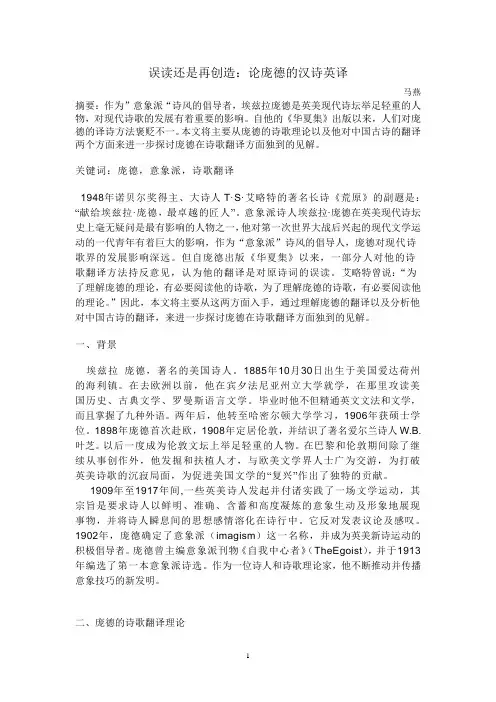
误读还是再创造:论庞德的汉诗英译-------马燕摘要:作为”意象派“诗风的倡导者,埃兹拉庞德是英美现代诗坛举足轻重的人物,对现代诗歌的发展有着重要的影响。
自他的《华夏集》出版以来,人们对庞德的译诗方法褒贬不一。
本文将主要从庞德的诗歌理论以及他对中国古诗的翻译两个方面来进一步探讨庞德在诗歌翻译方面独到的见解。
关键词:庞德,意象派,诗歌翻译1948年诺贝尔奖得主、大诗人T·S·艾略特的著名长诗《荒原》的副题是:“献给埃兹拉·庞德,最卓越的匠人”。
意象派诗人埃兹拉·庞德在英美现代诗坛史上毫无疑问是最有影响的人物之一,他对第一次世界大战后兴起的现代文学运动的一代青年有着巨大的影响,作为“意象派”诗风的倡导人,庞德对现代诗歌界的发展影响深远。
但自庞德出版《华夏集》以来,一部分人对他的诗歌翻译方法持反意见,认为他的翻译是对原诗词的误读。
艾略特曾说:“为了理解庞德的理论,有必要阅读他的诗歌,为了理解庞德的诗歌,有必要阅读他的理论。
”因此,本文将主要从这两方面入手,通过理解庞德的翻译以及分析他对中国古诗的翻译,来进一步探讨庞德在诗歌翻译方面独到的见解。
一、背景埃兹拉庞德,著名的美国诗人。
1885年10月30日出生于美国爱达荷州的海利镇。
在去欧洲以前,他在宾夕法尼亚州立大学就学,在那里攻读美国历史、古典文学、罗曼斯语言文学。
毕业时他不但精通英文文法和文学,而且掌握了九种外语。
两年后,他转至哈密尔顿大学学习,1906年获硕士学位。
1898年庞德首次赴欧,1908年定居伦敦,并结识了著名爱尔兰诗人W.B.叶芝。
以后一度成为伦敦文坛上举足轻重的人物。
在巴黎和伦敦期间除了继续从事创作外,他发掘和扶植人才,与欧美文学界人士广为交游,为打破英美诗歌的沉寂局面,为促进美国文学的“复兴”作出了独特的贡献。
1909年至1917年间,一些英美诗人发起并付诸实践了一场文学运动,其宗旨是要求诗人以鲜明、准确、含蓄和高度凝炼的意象生动及形象地展现事物,并将诗人瞬息间的思想感情溶化在诗行中。


艾兹拉。
庞德(Ezra Pound)
1885年出⽣于美国爱达荷州海莱市。
21岁时获宾⼣法尼亚⼤学⽂学硕⼠学位。
1909年前往伦敦,与当时在⽂坛上颇为活跃的休姆等⼈结识,庞德早期从事意象派的写作便是受这些⼈的影响。
1913年,弗。
福林特发表的意象派三点纲领,在两年后的《意象派诗选》的序⾔中,庞德⼜加了三条新原则:提倡⽤准确的⽇常语⾔,创造新的韵律以及⾃由选材。
这些主张对现代⾃由体诗的发展起了重⼤的作⽤,⽽也为庞德之后改写现代派诗作了准备。
1917年,庞德参与到温德汉。
路易斯创办的《风暴》杂志中,以表现⼒量为⽬的,宣扬应该改⾰意象派创作上的弊陋,要求那些善于写作平淡和伤感性诗歌的诗⼈⽤有⼒的、有运动感的意象和节奏来创作。
由于意见的相违,渐渐的庞德脱离出意象派。
1917年之后他开始了现代派的写作。
除此之外,庞德还是⼀个热衷于介绍中国古典诗歌和哲学的翻译家,经他改编并翻译了《神州⾏》、《诗经》等儒家经典。
代表作品:
《神州集》(1915年)
《休。
赛尔温。
莫伯利》(1920年)
《诗章》(1916-1968年)。


庞德的翻译观摘要:埃兹拉?庞德(ezra pound)乃美国著名诗人,意象派的代表人物,他翻译的中国古典诗歌对英语诗歌产生了重要影响,本文通过解析庞德的翻译理论和分析《华夏集》的译例,一窥他的创意翻译法,让大家领略不同于中国国内传统的翻译方法,并让读者认识到庞德的翻译作品带来的影响力远远超过翻译本身。
关键词:庞德;翻译观念;创意翻译法;中国古典诗歌埃兹拉?庞德是英美20世纪文坛最有影响的人物之一,他集诗人、批评家与翻译家于一身。
埃兹拉?庞德翻译了不少中国古典诗歌和儒家经典。
他的中国古典诗歌英译不但很好地介绍了中国文化,而且恰当地将中国诗学精髓用之于发展英语现代诗歌,同时又突出地表现了他的创意翻译法。
虽然庞德的诗学和翻译与中国文化的渊源很深,但国内对其诗学和译学的研究一直没有重大突破,甚至有不少人将庞德的翻译看作是劣质翻译品,本文试对庞德的翻译理论初作探讨,以期抛砖引玉,让庞德的翻译理论和译作在中国能够得到中肯的评价。
一、20世纪的翻译理论介绍20世纪以前的西方译论主要是围绕“直译”与“意译”展开,20世纪朝着哲学、语言学和文化三个主要方向发展。
庞德翻译理论对20世纪西方翻译理论的发展影响深远,预示着翻译理论从语言学范式到文化范式的发展方向。
二、庞德的翻译理论庞德翻译理论的核心在于创意翻译,而他的创意翻译又体现在如下三方面:(一)翻译是对原作的部分批评庞德1934年提出“通过翻译批评”的观点。
庞德认为翻译是对原作的批评。
但与维多利亚翻译家“翻译即批评”的观点不同的是,庞德认为翻译是对原作的部分批评。
“庞德与维多利亚时期翻译理论的最根本的差别在于庞德不再现原诗的所有特征,无论其特征是理想还是不理想。
”(apter,1984:106)庞德认为,翻译家不应着力重现原文所有的特征,而应向读者“展示原文的宝藏”,即展示原文的本质特征,展示原文独特的品质,哪怕是损失其他的品质,以传达原作者的思想意识及原作整体的美学效果。
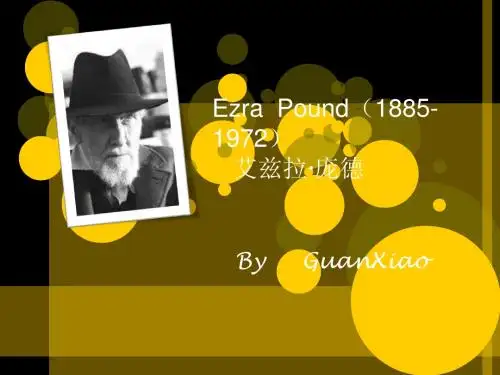
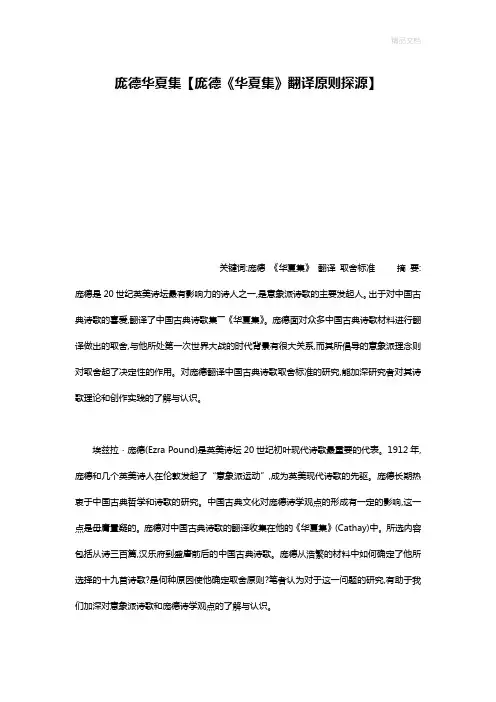
庞德华夏集【庞德《华夏集》翻译原则探源】关键词:庞德《华夏集》翻译取舍标准摘要:庞德是20世纪英美诗坛最有影响力的诗人之一,是意象派诗歌的主要发起人。
出于对中国古典诗歌的喜爱,翻译了中国古典诗歌集――《华夏集》。
庞德面对众多中国古典诗歌材料进行翻译做出的取舍,与他所处第一次世界大战的时代背景有很大关系,而其所倡导的意象派理念则对取舍起了决定性的作用。
对庞德翻译中国古典诗歌取舍标准的研究,能加深研究者对其诗歌理论和创作实践的了解与认识。
埃兹拉・庞德(Ezra Pound)是英美诗坛20世纪初叶现代诗歌最重要的代表。
1912年,庞德和几个英美诗人在伦敦发起了“意象派运动”,成为英美现代诗歌的先驱。
庞德长期热衷于中国古典哲学和诗歌的研究。
中国古典文化对庞德诗学观点的形成有一定的影响,这一点是毋庸置疑的。
庞德对中国古典诗歌的翻译收集在他的《华夏集》(Cathay)中。
所选内容包括从诗三百篇,汉乐府到盛唐前后的中国古典诗歌。
庞德从浩繁的材料中如何确定了他所选择的十九首诗歌?是何种原因使他确定取舍原则?笔者认为对于这一问题的研究,有助于我们加深对意象派诗歌和庞德诗学观点的了解与认识。
一、第一次世界大战对庞德翻译中国古典诗歌的影响庞德研究中国古典诗歌有一个机缘,美国东方文化学者欧内斯特・费诺罗萨(Ernest Fenollosa)曾长期旅居东京,对东亚文化有浓厚兴趣,用长达数年的时间向日本汉学家学习中国古典诗歌,死后留下大量的读书笔记。
费诺罗萨的妻子玛丽・费诺罗萨在丈夫去世后,一直在寻找能够理解和完成丈夫遗愿的西方学者。
当她读到庞德的象形文字诗歌后,感觉遇到了知音。
1912年,玛丽将丈夫的研究笔记和手稿交给了庞德,当他阅读完遗稿,爱不释手,如获至宝,并开始潜心研究。
1915年,庞德借鉴了费诺罗萨的研究成果,进行了必要的取舍再创作,出版了中国古典诗歌集――《华夏集》。
诗集发表后,很快赢得了英美诗坛的普遍赞扬,评论家认为它是庞德对英语诗歌“最持久的贡献”,是英语诗歌中的经典作品。


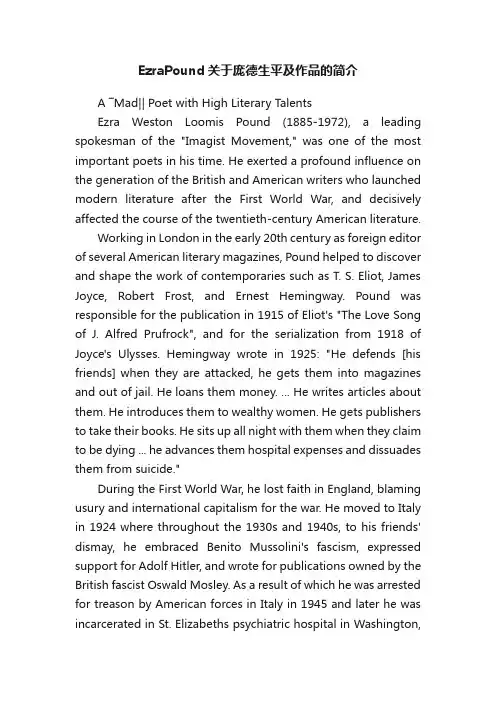
EzraPound关于庞德生平及作品的简介A ―Mad‖ Poet with High Literary TalentsEzra Weston Loomis Pound (1885-1972), a leading spokesman of the "Imagist Movement," was one of the most important poets in his time. He exerted a profound influence on the generation of the British and American writers who launched modern literature after the First World War, and decisively affected the course of the twentieth-century American literature.Working in London in the early 20th century as foreign editor of several American literary magazines, Pound helped to discover and shape the work of contemporaries such as T. S. Eliot, James Joyce, Robert Frost, and Ernest Hemingway. Pound was responsible for the publication in 1915 of Eliot's "The Love Song of J. Alfred Prufrock", and for the serialization from 1918 of Joyce's Ulysses. Hemingway wrote in 1925: "He defends [his friends] when they are attacked, he gets them into magazines and out of jail. He loans them money. ... He writes articles about them. He introduces them to wealthy women. He gets publishers to take their books. He sits up all night with them when they claim to be dying ... he advances them hospital expenses and dissuades them from suicide."During the First World War, he lost faith in England, blaming usury and international capitalism for the war. He moved to Italy in 1924 where throughout the 1930s and 1940s, to his friends' dismay, he embraced Benito Mussolini's fascism, expressed support for Adolf Hitler, and wrote for publications owned by the British fascist Oswald Mosley. As a result of which he was arrested for treason by American forces in Italy in 1945 and later he was incarcerated in St. Elizabeths psychiatric hospital in Washington,D.C., for over 12 years. He was released from St. Elizabeths in 1958, thanks to a protracted campaign by his fellow writers, and returned to live in Italy until his death.While in custody in Italy he had begun work on sections of The Cantos that became known as The Pisan Cantos (1948), for which he was awarded the Bollingen Prize in 1949 by the Library of Congress. The honor triggered enormous controversy, mostly because of his anti-semitism, and in part because it raised literary questions about whether a supposedly "mad" poet who held such contentious views could produce work of any value. His political views ensure that his work remains controversial; in 1933 Time magazine called him "a cat that walks by himself, tenaciously unhousebroken and very unsafe for children."Despite the fact that he was politically controversial and notorious for what he did in the wartime, Pound's literary talents are extraordinary. He composed poems, wrote criticisms and did translations. His commitment to poetry was total: to poetry as a craft, as a moral and spiritual resource and eventually as a means of salvaging culture, redeeming history. Pound's poetic works include twelve volumes of verse which were later collected and published in Collect- ed Early Poems of Ezra Pound(1982), and Personae(1909), and some longer pieces such as Hugh Selwya Mauberley (1920) and his life's work, the one hundred and sixteen Cantos that he published between 1916 and 1969.The Imagist MovementPound's artistic talents are on full display in the history of the Imagist Movement, which flourished from 1909 to 1917 and involved quite a number of British and American writers and poets. This is a movement that advanced modernism in arts which concentrated on reforming the medium of poetry asopposed to Romanticism, especially Tennyson's wordiness and high-flown language in poetry. As one of the leaders of the Imagists, Pound endorsed the group's three main principles, which include directtreatment of poetic subjects, elimination of merely ornamental or superfluous words, and rhythmical composition in the sequence of the musical phrase rather than in the sequence of a metronome. "The point of Imagism," Pound wrote in 1914, "is that it does not use images as ornaments. The image itself is the speech. The image is the word beyond formulated language.‖ Obviously the primary Imagist objective is to avoid rhetoric and moralizing, to stick closely to the object or experience being described, and to move from explicit generalization. Pound's famous one-image poem "In a Station of the Metro" would serve as a typical example of the Imagist ideas.In a Station of the MetroThe apparition of these faces in the crowd;Petals on a wet, black bough.This poem is an observation of the poet of the human faces seen in a Paris subway station. This little poem looks to be a modern adoption of the Japanese haiku. Pound wrote an account of its composition, however, which claims that the poem's form was determined by the experience that inspired it, evolving organically rather than being chosen arbitrarily. Whether truth or myth, thepiece has become a famous document in the history of Imagism.The CantosPound's earlier poetry is saturated with the familiar poetic subjects that characterize the 19th century Romanticism: songsin praise of a lady, songs concerning the poet's craft, love and friendship, death, the transience of beauty and the permanence of art, and some other subjects that Pound could call his own: the pain of exile, metamorphosis, the delightful psychic experience, the ecstatic moment, etc. Later he is more concerned about the problems of the modem culture: the contemporary cultural decay and the possible sources of cultural renewal as well. Take his epic poem, The Cantos, for example. Pound traces the rise and fall of eastern and western empires, the moral and social chaos of the modern world, especially the corruption of America after the heroic time of Jefferson. Hemingway wrote, "The best of Pound's writing—and it is in the Cantos—will last as long as there is any literature." From the perception of these things, stems the poet's search for order, which involves a search for the principles on which the poet's craft is based.The bulk of Pound's work on The Cantos began after his move toItaly. Like all the other great epics, it is the story of good and evil, a descent into hell and progress to paradise. Its hundreds of characters fall into three groups: those who enjoy hell and stay there; those who experience a metamorphosis and want to leave; and a few who lead the rest to paradiso terrestre. He began work on it in 1915, but there were several false starts and he abandoned most of his earlier drafts, beginning again in 1922.The subject matter ranges from Odysseus, Troy, Dionysus, Malatesta, Confucius, and Napoleon, to Jefferson and Mussolini, Chinese history, Pisa, and usury, relying on memories, diaries, jokes, hymns, anecdotes, ideogrammic translation, and up to 15 different languages.The Other Two WritersRobert Lee Frost (1874 –1963) was an American poet who is highly regarded for his realistic depictions of rural life and his command of American colloquial speech. His work frequently employed settings from rural life in New England in the early twentieth century, using them to examine complex social and philosophical themes. A popular and often-quoted poet, Frost was honored frequently during his lifetime, receiving four Pulitzer Prizes for Poetry.William Cuthbert Faulkner (1897–1962) was an American writer of novels, short stories, poetry and occasional screenplays. The majority of his works are based in his native state of Mississippi. Faulkner was known for his experimental style with meticulous attention to diction and cadence. In contrast to the minimalist understatement of his contemporary Ernest Hemingway, Faulkner made frequent use of "stream of consciousness" in his writing, and wrote often highly emotional, subtle, cerebral, complex, and sometimes Gothic or grotesque stories of a wide variety of characters including former slaves or descendants of slaves, poor white, agrarian, or working-class Southerners, and Southern aristocrats. Two of his works, A Fable (1954) and his last novel The Reivers (1962), both won the Pulitzer Prize for Fiction.。
从庞德的诗歌翻译语言观看英美儿童诗的翻译作者:刘一鸣来源:《文教资料》2011年第24期摘要:本文以庞德的诗歌翻译语言观为基础,结合儿童诗的特点,分别从音乐美、意象美、意境美三方面探讨了英美儿童诗翻译应注意的基本问题,指出儿童诗的翻译应从整体着眼,在语言的处理上灵活变通,“儿童味”才是译者的主要着眼点。
关键词:庞德诗歌翻译英美儿童诗一、庞德的诗歌翻译语言观埃兹拉·庞德(Ezra Pound,1965—1972)是二十世纪英美文坛的巨擘之一,他不仅是英美现代主义诗歌的主要奠基人,而且以其突破传统的翻译观念和翻译手法推动了英美诗歌现代化的进程和翻译学的发展。
西方评论界认为,庞德翻译理论的核心是其诗歌翻译语言观。
在早期的意想主义运动时期,庞德注重细节和单个意象的精确翻译,把其翻译观建立在语言能量与活力的基础上。
他认为,语言是富有活力的,在不断的变化中彰显其生命力,因此,诗歌翻译应通过诗的节奏、意象和变化让诗歌语言迸发出巨大的能量。
这种翻译观无疑给了译者更大的自由空间,诗歌翻译也因此而具有了更多的灵活性和艺术性。
庞德在《如何阅读》一文中根据诗歌的语言特征,将诗歌分为三类,即“声诗”(melopoeia)、“形诗”(phanopoeia)和“理诗”(logopoeia),[1]并对这三类诗的翻译做出如下阐释:“声诗可被一位听觉敏锐的外国人所赏识,尽管他对诗歌所有的语言一窍不通。
声诗其实不可能从一种语言翻译到另一种语言,除非有天生的巧合,再加上仅译半句。
与此相反,形诗几乎或完全可以不差分厘地翻译过来。
好的形诗,译者其实不可能破坏它,除非他粗制滥造,忽视众所皆知的常规。
理诗无法翻译,虽然它所表达的意向可以意译。
或者说,你无法‘就事论事地翻译’,只有在确定作者的意图之后,你或可找到一个派生或相应的结构。
”[2]庞德作为诗人兼翻译家,在诗歌英译方面功不可没,其独到的诗歌翻译观不仅对英语诗歌的发展有着积极的推动作用,而且对英诗汉译也有一定的指导作用。
Ezra Pound埃兹拉·庞德(Ezra Pound),美国著名诗人。
1885年10月30日出生于美国爱达荷州的海利镇。
在去欧洲以前,他在宾西法尼亚州立大学就学,在那里攻读美国历史、古典文学、罗曼斯语言文学。
两年后,他转至哈密尔顿大学(Hamilton College)学习,1906年获硕士学位。
1898年庞德首次赴欧,以后于1902年,1906年及1908年先后共四次去欧洲。
1908年定居伦敦,以后一度成为伦敦文坛上举足轻重的人物。
1908年庞德的第一部诗集《灯火熄灭之时》(A Lume Spento)在意大利威尼斯自费出版。
1909年,他的诗集《人物》(Personae)在伦敦出版。
1910年他的文集《罗曼斯精神》(The Spirit of Romance)出版。
文集内容主要是他的早期译作及他历年来学术研究的成果和见解。
庞德在他早期诗作中就显示出独创精神和渊博的学识,1912年他成为芝加哥小型杂志《诗歌》驻伦敦通讯员。
1914年他与多萝西·莎士比亚(Dorothy Shakespeare)结婚。
1915年庞德发表了他根据东方学者芬诺洛萨(Fenollosa)的遗稿而译成的中国古诗英译本《中国》(Cathay)及两个日本戏剧集。
在伦敦期间他发表的另外两部著作是:《向塞克斯图斯·普罗佩提乌斯致敬》(Homage to Sextus Propertivs,1919)和《休·赛尔温·毛伯利》(Hugh Selwyn Mauberley,1920)。
1921年庞德移居巴黎,1924年迁居意大利热那亚东南的拉巴洛。
在巴黎和伦敦期间除了继续从事创作外,他发掘和扶植人才,与欧美文学界人士广为交游,为打破英美文学,尤其是英美诗歌的沉寂局面,为促进美国文学的“复兴”作出了独特的贡献。
他和雕塑家、画家、音乐家都有广泛的联系,对欧美各国现代主义思潮的形成和发展都起了相当重要的作用。